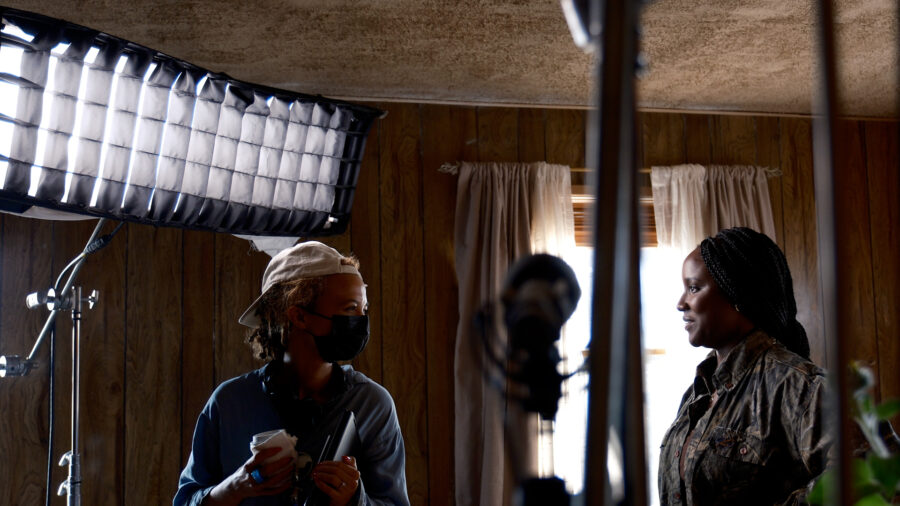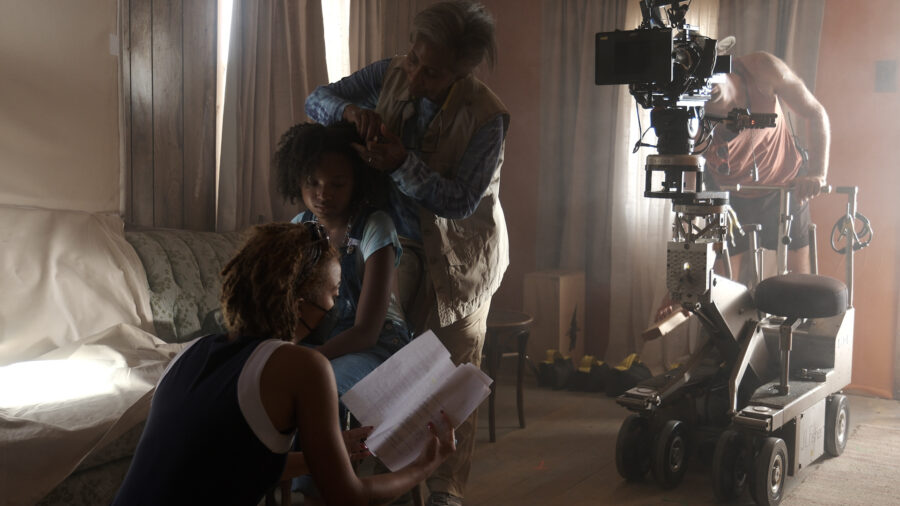
CineD is always searching for a way to connect creators and manufacturers – and, of course, to help filmmakers show their work. This is why we teamed up with FUJIFILM to show our filming community work that has been done with FUJIFILM cameras. If you use a FUJIFILM camera and are interested in getting your work featured, click here to learn more. For our next “In the Spotlight” article, please meet Director/Writer Annalise Lockhart. “In the Spotlight” is proudly sponsored by FUJIFILM.
Annalise Lockhart is a writer & director, born and raised in NYC. Her first short film Inheritance (2021) won numerous awards, including Best US Short at the Palm Springs Shortfest, the Lionsgate/Starz Award for Best Speculative Fiction at BlackStar Film Festival, and Best Director: Fantastic Shorts at Fantastic Fest.
She has worked extensively as a 1st Assistant Director on projects such as Reservation Dogs (FX), Random Acts of Flyness (HBO), The Assistant, and The Fits.
Name: Annalise Lockhart
Currently based in: New York
Language(s) spoken: English
Occupation: Writer/Director
Q: How did you get started in our industry?
A: I studied creative writing and music as an undergraduate at Stanford. I was pretty sure I wanted to go into film, but I initially started from a place of storytelling, with the understanding that the medium would come later. Right after graduating, I was lucky enough to get a job as a 2nd Assistant Director on a feature in San Francisco. From there I continued to work in the AD department and quickly began working as a 1st Assistant Director. I got to work on a number of fiction narrative features, and eventually TV. In 2019, I started transitioning over to writing and directing.
Q: What are some of the projects you are currently working on?
A: I’m currently working on a short documentary related to prison reform in New York State, as well as developing a number of fiction projects.

Q: What types of productions do you mostly shoot?
A: I mostly work on fiction narrative pieces and occasionally short documentary formats.
Q: What is your dream assignment/job in our industry and what are you passionate about?
A: I’m really passionate about science fiction and horror. I’ve found that some of the toughest questions about humanity can only be answered by examining a parallel world to our own. My dream assignment would probably be developing one of my favorite science fiction series for television! To me, nothing is better than getting to build a new world in your work.
Q: In regard to the work you’ve shared with us – looking back, is there anything you would have done differently?
A: I had so much fun making Mirasol. It was a tough shoot because we really crammed as much as we could into a couple of days. On top of that, we were filming in the desert in southern California in the middle of the summer. I think if I would have done anything differently, and this applies to any art-making endeavor, I would go back and tell myself to take a step back and take my time. Doing two things slower is always better than doing five things rushed.

Q: What current camera, lenses, and sound equipment do you use?
A: It usually depends on which DP I’m working with. Though my next personal project is likely going to be on film.
Q: You chose to shoot your project with the FUJIFILM X-H2 camera. Did you impose on yourself any limitations like not shooting with a tripod?
A: We were limited to a two-day shoot, which meant we needed to move quickly and nimbly. Scheduling dictated that we finish our second day on the most complex setup/climax of the film – a mirror gag involving duplicating a greenhouse of sunflowers in camera. So while we were rushing to film this smattering of sunflowers in a tight space with time running out, we were able to bypass that limitation by shooting in 8K, giving ourselves more pixels of footage to work with in the edit. There’s just no way we could have pulled that scene off otherwise!
Beyond that, we really wanted to stretch the camera’s capabilities as far as they could go into a world that emulates film to deliver something cinematic that gestures back toward classic science fiction and fantasy. Due to our space constraints in the tiny, cramped farmhouse, many of our scenes ended up being on sticks, which is unusual for me. In the end, I think it served the story. Even though the film is set in the future, I wanted there to be a fable-like quality to it, so watching the characters’ lives play out in locked-off frames makes each scene feel like a snapshot of their life. Like picking up an old photograph.

Q: What’s your favorite lighting equipment and why did you choose that kit over other solutions?
A: I called in my DP Charlotte Hornsby to answer these questions. Charlotte really likes to have a combination of tungsten, HMI, and LED units that she can scale up or down depending on the scope and needs of the project. For Mirasol, we landed on an M40 and a Joker 800 that we pushed through the farmhouse windows, as well as a Litemat 2L and 4-tube titan kit to help wrap daylight inside, a Fiilex Q8, and a covered wagon we used at night to emulate candlelight. Ryan Apley, our gaffer, and Hot Points Lighting really helped us out by making this package work with our budget.
Q: Do you use drones/gimbals in your productions? If so, what is the most effective way you’ve found to deploy them?
A: We used a drone for the opening and closing scenes. I find drones most effective when showing the relationship between the subject and the world around them. In Mirasol, the vast, lonely plains around their house play in contrast to the small, mighty seedling that she cultivates.
Q: What editing systems do you use and are you satisfied working with them?
A: Our editor Zak Byrd edited Mirasol in Premiere Pro on an iMac Pro. Working with the X-H2 footage on this system was a breeze, and we never felt bogged down by the large files. We had to assemble some overlay montages of sunflowers, and shooting in 8K allowed us to resize and reframe that footage in unique ways without sacrificing any picture sharpness. In order to appreciate the remarkable color palette that the camera’s X-Trans CMOS 5 HR sensor is able to produce, we used the Dell U2720Q as our playback monitor. Colors of the desert that are normally imperceptible to the camera’s eye saturated the image, which complemented the film’s message of hope despite the arid landscape where the characters were living.

Q: How much of your work do you shoot in “flat picture profile”, and what is your preferred way of color correcting?
A: Charlotte and I always shoot in a log color space to preserve as much information in the digital negative as possible. We shot Mirasol in Fujifilm’s F-Log and did the DI with an incredible colorist at Light Iron, Sam Daley.
Q: How frequently do you travel and do you have any tips when it comes to packing your gear?
A: As a director, I don’t travel with gear that often, so I reached out to Charlotte (DP) again to ask for her advice on this question. She said, “I travel frequently for work and the more gear I bring with me that has to be carried on, the trickier it gets. I’m currently scouting for my next feature and I finally invested in a wheeled carry-on that houses 2 DSLRs and an SLR so I can have options for scout photos without breaking my back.”
Find out more about Annalise’s work by heading to her website.
Full disclosure: This “In The Spotlight” series of interviews is sponsored by FUJIFILM.




































